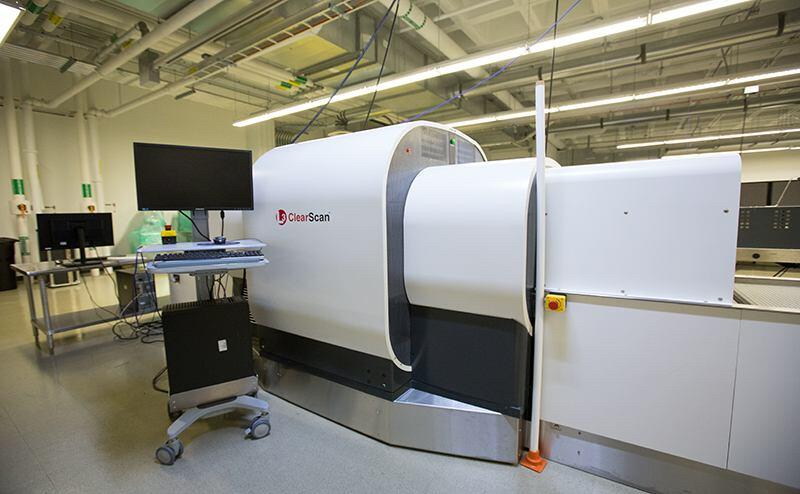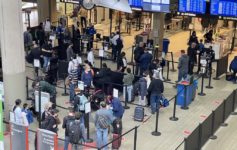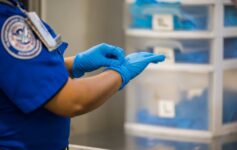The widespread use of new technology promises to speed up airport security lines by no longer requiring that laptops or liquids be removed from carry-on bags.
It has now been 13 years since the carry-on liquid ban went into effect. For 13 years, passengers have had to carefully pack liquids into containers smaller than 100mL (3.5 oz) and consolidate them into a single quart-size resealable bag. For 13 years we’ve had to take those bags out and ensure nothing was accidentally left in the bag…or face even more time-consuming secondary screening. And for 13 years we’ve been annoyed by the people in front of us who seem to have never traveled before and become surprised or indignant as they fish through for bags for liquids.
And it’s not just liquids…we’ve had to take out laptops and other electronic devices and screen them in separate bins. While PreCheck has alleviated this issue for frequent travelers in the USA, this arduous (and ineffective) process continues around the world.
But computed tomography (CT) offers the chance to finally move to a more advanced, less intrusive manner of security screening. Just like in the doctor’s office, CT creates 3D images of the contents of a carry-on bag, allowing for a far more comprehensive check than current x-ray devices. The new technology will begin rolling out at more checkpoints this summer, including some of the world’s busiest airports.
The Rollout
In the USA, the TSA has acquired 300 machines. It will deploy them at more checkpoints and more airports this summer after successful trials in:
- Hartsfield-Jackson Atlanta International Airport (ATL)
- Baltimore-Washington International Airport (BWI)
- Chicago O’Hare International Airport (ORD)
- Cincinnati/Northern Kentucky International Airport (CVG)
- Detroit Metropolitan Wayne County Airport (DTW)
- Houston Hobby Airport (HOU)
- Indianapolis International Airport (IND)
- John F. Kennedy International Airport (JFK)
- Logan International Airport (BOS)
- Los Angeles International Airport (LAX)
- Miami International Airport (MIA)
- Oakland International Airport (OAK)
- Phoenix Sky Harbor International Airport (PHX)
- Ronald Reagan Washington National Airport (DCA)
- St. Louis Lambert International Airport (STL)
- Tampa International Airport (TPA)
- Washington-Dulles International Airport (IAD)
London Heathrow is also acquiring machines and if the trial is successful, we will see them all over the United Kingdom within the next three years.
Chris Garton, the Chief Operating Officer of LHR, told Forbes:
Heathrow has a proud history of investing in making every journey better for our customers and that’s why we’re delighted to be rolling out our new 3D security screening machines. This cutting-edge equipment will not only keep the airport safe with the latest technology but will also mean that our future passengers can keep their focus on getting on with their journeys and spend less time preparing for security screening.
CONCLUSION
At least for now, liquids will still be limited to smaller containers. Even so, I am thrilled to see technology–especially at London Heathrow–that may speed up the screening experience while lessening the inconvenience.
image: TSA




Don’t forget shampoo, hair gel, hairspray, creams, lotions, potions, lube, apple juice, donut filling, and other items of a similar consistency… https://www.youtube.com/watch?v=xARiFIew8Ao
All we really need to do is strategic profiling which is what the Israelis do (keep in mind, most secure airport in the world), then we could make the process very efficient while not inconveniencing most folks.
I have experienced Israeli security. My belief is that they treat every liquid the same, with no regard for who is travelling with it. They just have better technology at their disposal. It seems they act as if their life depends on it.
Israeli profile is even more time consuming and the questioning extremely invasive. It’s awful if you have ever been through it. Also look at numbers of passengers screened in tel Aviv compared to large airports like JFK and lhr.
Not an expert on the technology, but CT also has many times more radiation exposure than X-ray, at least for medical purposes.
Wouldn’t this be an issue for frequent travelers, getting multiple CT level doses of radiation?
The bags are being exposed to this higher level of radiation. You are not.
I’ve never packed my liquids separately in a plastic bag and separated them for screening. I’ve never been stopped at security to take them out or anything.
@Matthew… sorry… I am one of these passengers, but let me explain myself…
“And for 13 years we’ve been annoyed by the people in front of us who seem to have never traveled before and become surprised or indignant as they fish through for bags for liquids.”
The thing is, my wife has packed her liquids in a quart bag for the past 10 years and I have not (I just leave mine in my bag). I don’t fly a TON. I have had maybe 200-250 segments in the past 10 years and only ONCE have I had to take my liquids out – I left the terminal at LHR just to walk around for a bit and was held up for almost 30 minutes for trying to get my travel sized container of contact solution into the airport. I just don’t think it’s worth it for the < 1% of the time I am/we are held up to use a plastic bag every time… sorry for the inconvenience 🙂
Love your blog BTW!
That’s all well and good for you, but multiply that by about1,000 other asshats per day who claim “It’s only happend to me once, so I’m perfectly justified in not following the rules and inconveniencing everyone else if I get called out…” and then you have a nice, steady slow down. THAT is the problem. But good for you for being a super special princess!
Schiphol Amsterdam Intercontinental is already fully CT scans, and Schengen will be fully CT before the end of this year
Changi T4 opened with CT scanners.
The continued liquids ban has really just been security theatre for the most part.
There is technology to screen for explosives, including liquids. All that needs to be done is to use it more!
In Australian domestic airports, they do not have such liquid restrictions and it only applies to international because everyone else forces them to. Japan is similar if I recall.
“While PreCheck has alleviated this issue for frequent travelers in the USA…”
The PreCheck line has become markedly worse ever since credit cards started paying for the fee and enrollment exploded. Now you have to get Clear to experience what PreCheck used to be.
There are still people in PreCheck who take laptops out of their bags, small coats off, get individual bins for each item, it’s maddening. And doubly so for people who apparently forgot they were headed to an aiport today and stuffed every pocket full of change, pens, gum. I walk into the airport with my ID/phone in my pockets and everything else in my backpack. Not that hard.